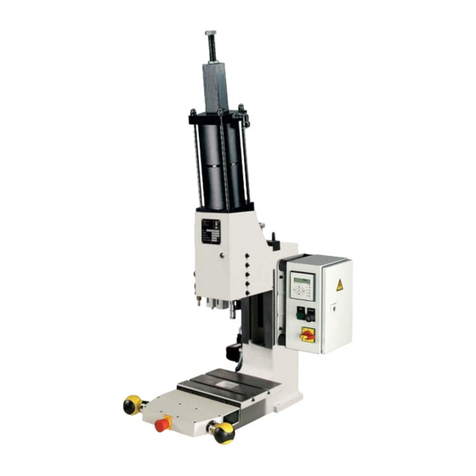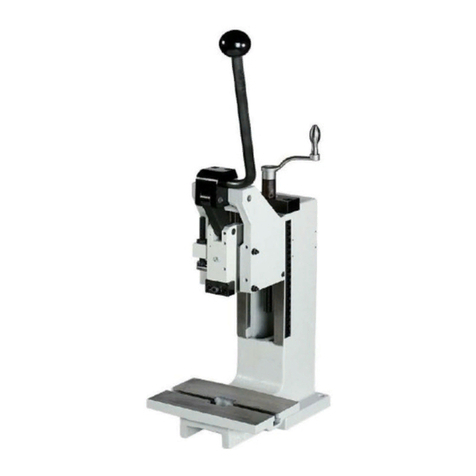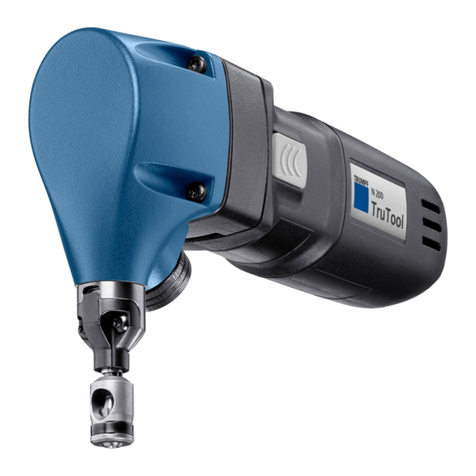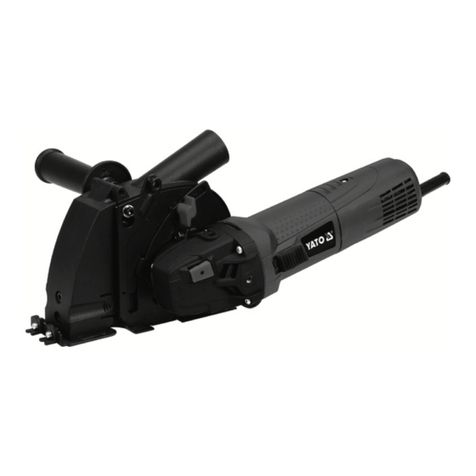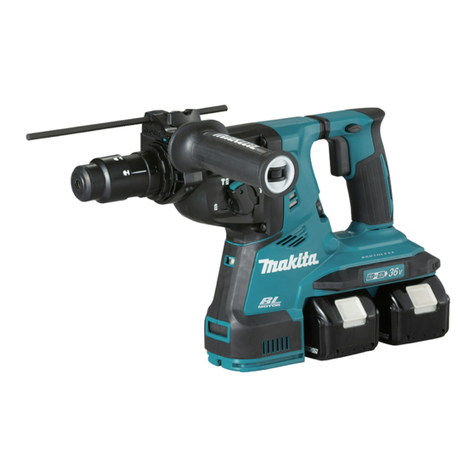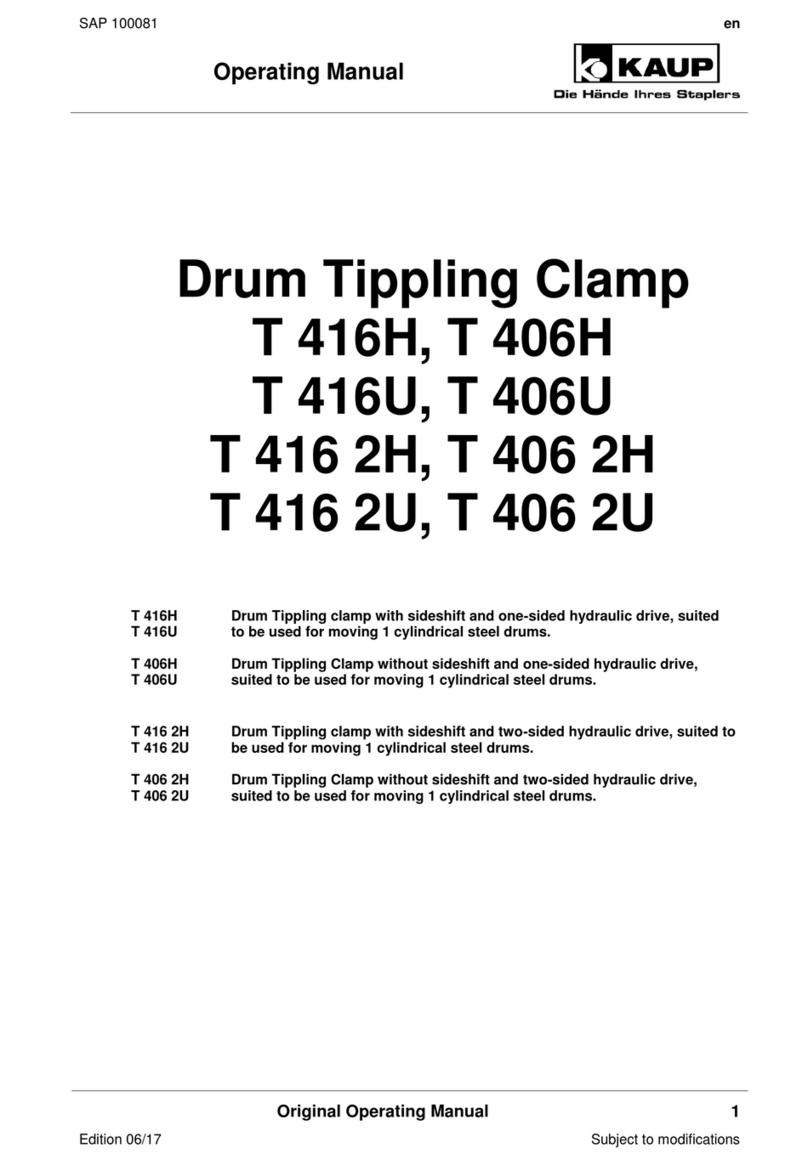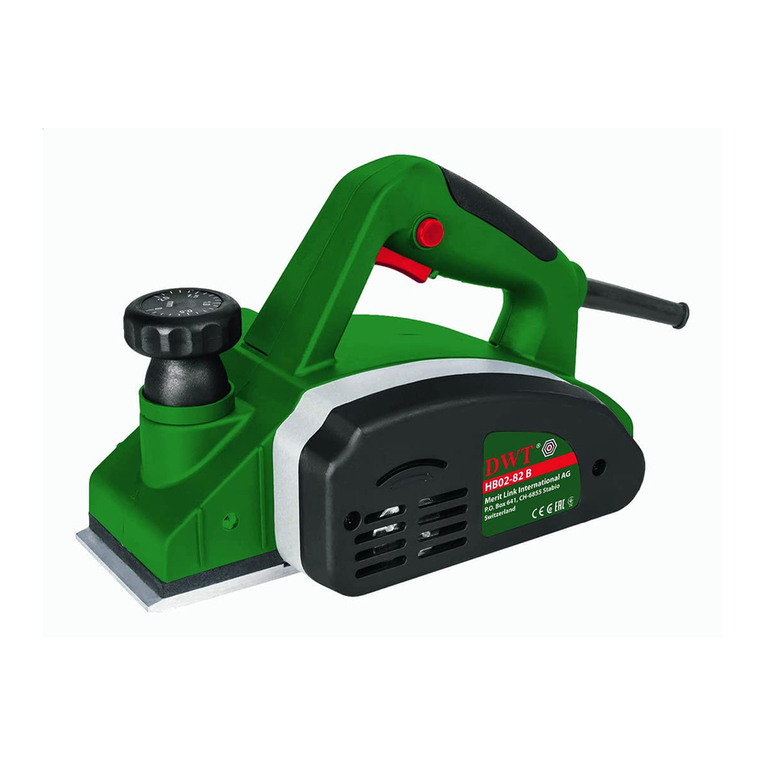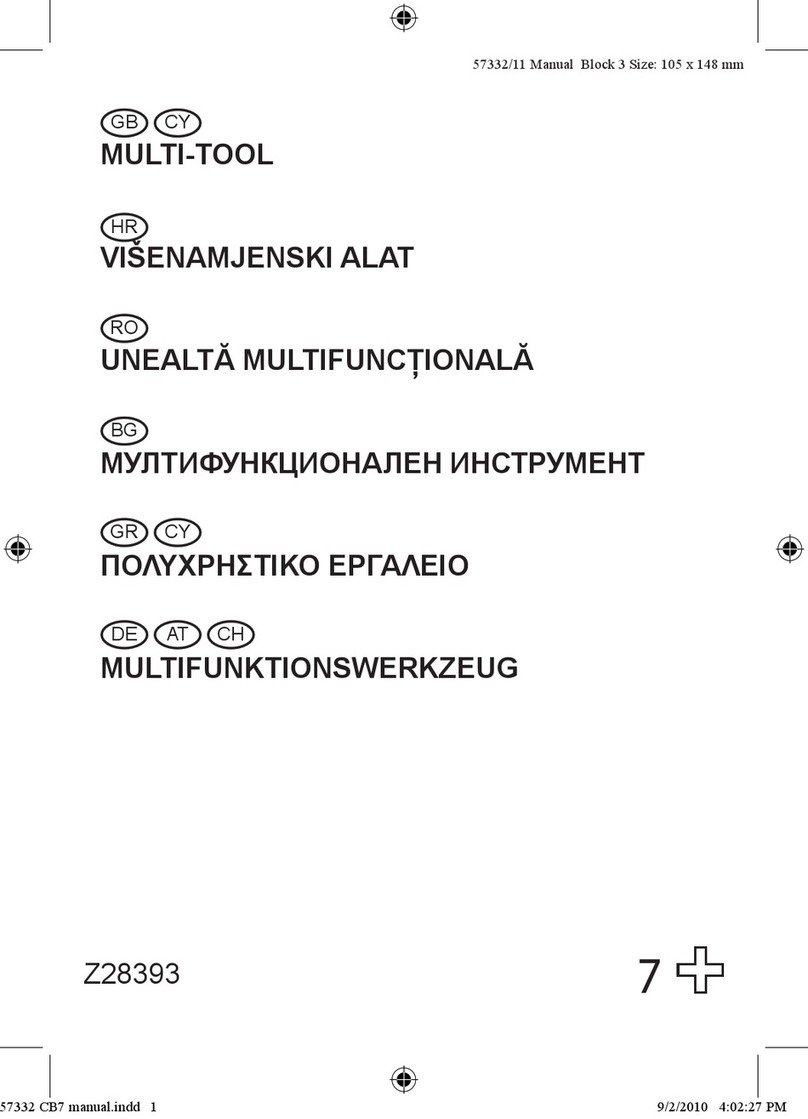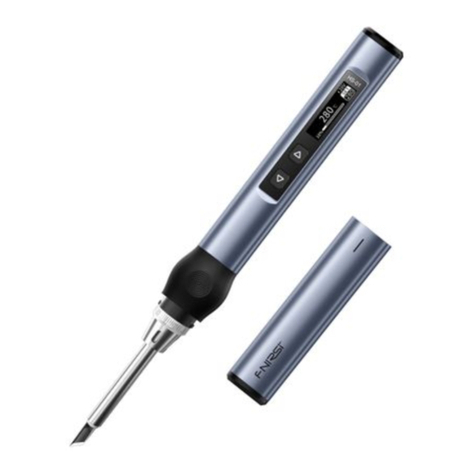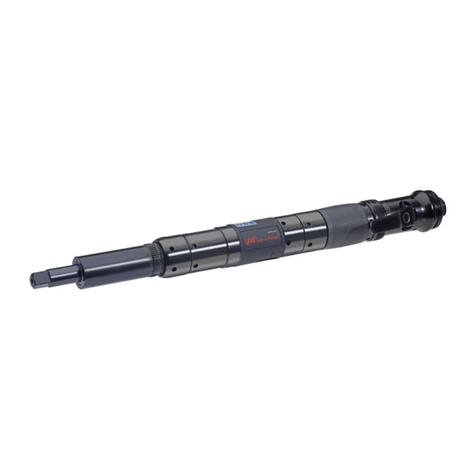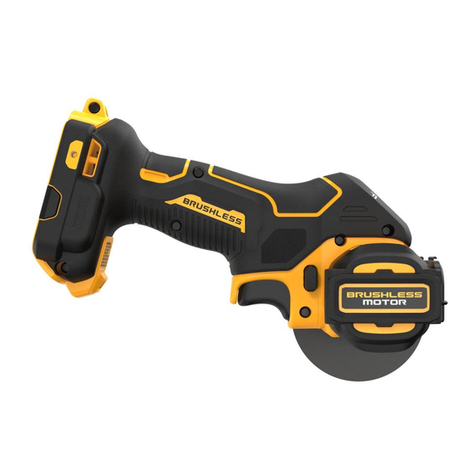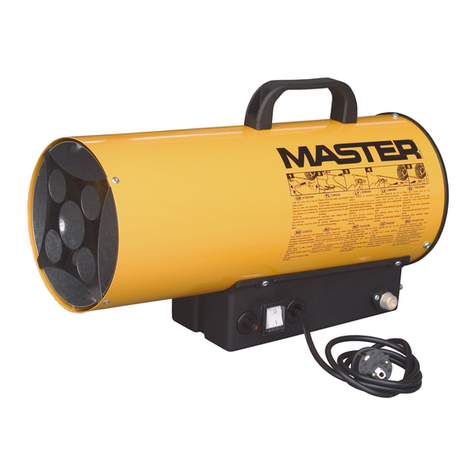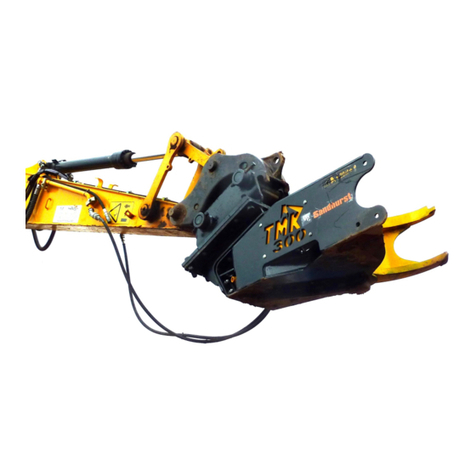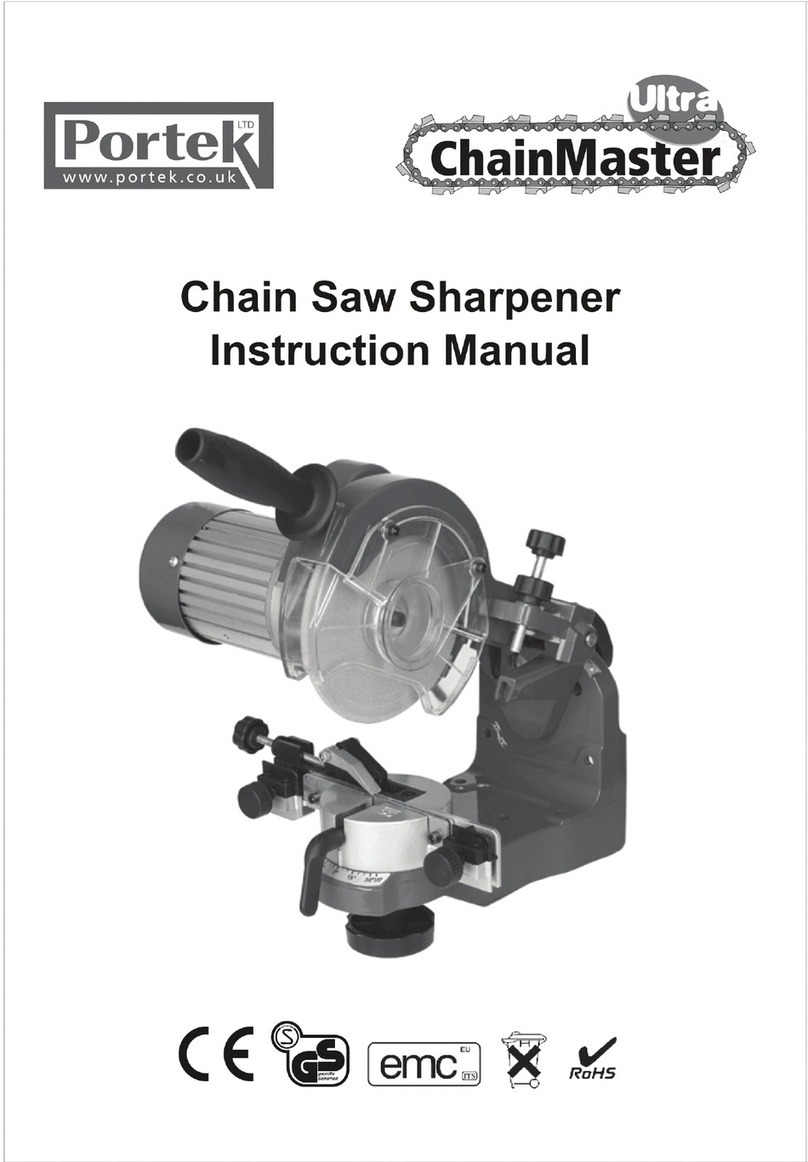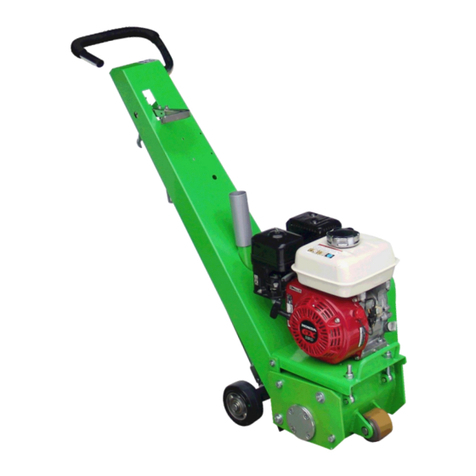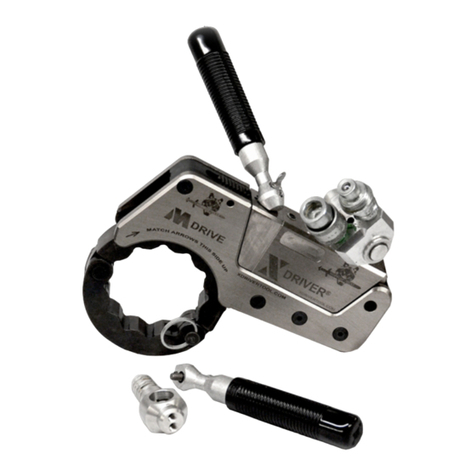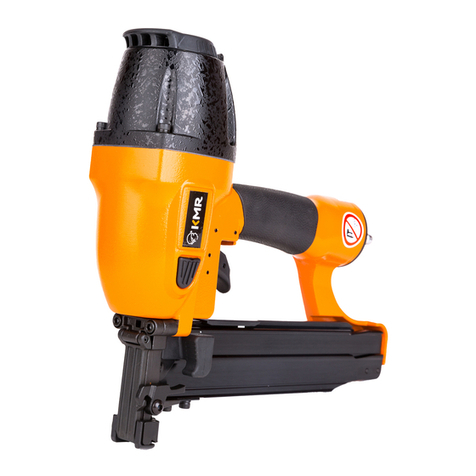Gechter HKPL-DS Operational manual

Gechter GmbH Werkzeug- und Maschinenbau
Translation of the original operating
manual
English
Hand lever press with air assistance
Type:
HKPL-DS standard, MS and MC
4-8-12 kN, 13-20 kN, 33-45-56 kN
Example representation
The operating manual must be read prior to the initial commis-
sioning!
Observe the safety instructions!
Keep for future use!
This documentation is not subject to any change service!
November 2016 - May 2019 Version: 00
June 2019 - December 2020 Version: 01
January 2021 Version: 02

Information
i
This operating manual is part of the technical documentation of the press according to the
EC press guideline.
This operating manual complies with the "Directive 2006/42/EC of the European Parliament
and the Council on the Approximation of the Legal and Administrative Provisions of the Mem-
ber States Relating to Presses" (Press Directive), appendix I, point 1.7.4.
This operating manual is aimed at those responsible in the plant who must hand this over to
the personnel responsible for the installation, connection, use and maintenance of the press.
The responsible persons must ensure that the information contained in the operating manual
and in the accompanying documents has been read and understood.
The operating manual must be stored in a known and easy-to-access location and must also be
consulted even in cases of minor doubt.
The manufacturer assumes no liability for damage to people, animals or objects as well as the
press itself, which is caused from improper use, neglect or insufficient observance of the safety
criteria contained in this operating manual or that is caused by modifying the press or using
unsuitable spare parts.
The copyright for the operating manual lies exclusively with
Gechter GmbH Werkzeug- und Maschinenbau
Ostring 3
90587 Obermichelbach
GERMANY
or with their legal successor.
This operating manual may only be duplicated or passed on to third parties with written ap-
proval. This is also the case if only excerpts of the operating manual are copied or forwarded.
The same conditions exist for passing on the operating manual in digital form.

Information
i
Archiving
Always store the operating manual on the press!
Always keep the manual handy!
Symbols and Signal Words
The following symbols and signal words are used in this documentation. The
combination of a pictogram and a signal word classifies the respective safety
note. The symbol may vary depending on the type of hazard.
ANSI Z535.6
DANGER indicates a hazard-
ous situation which, if not
avoided, will result in death
or serious injury.
WARNING indicates a hazard-
ous situation which, if not
avoided, could relust in death
or serious injury.
CAUTION indicates a hazard-
ous situation which, if not
avoided, could result in minor
or moderate injury.
NOTICE is used to address
practices not related to physi-
cal injury.
Safety instructions (or
equivalent) signs indicate
specific safety-related instruc-
tions or procedures.

Content
I
1
1. Identification ...........................................................................................1
1.1 Use in accordance with the intended purpose 1
1.2 Reasonably Foreseeable Misapplication 2
2. General Information ................................................................................3
2.1 Warranty and liability 3
2.2 Target group of the operating manual 3
2.3 Objectives of the operating manual 4
3. General Safety Instructions .....................................................................5
3.1 Scope and Symbols 5
3.1.1 Safety symbols –pursuant to DIN 4844-2 5
3.2 Obligations 6
3.2.1 Operator responsibilities 6
3.2.2 Obligations of the operating personnel 7
3.2.3 Orientation values for lifting and carrying frequencies 8
3.3 Working, service and protection areae 9
3.4 Safety Devices 10
3.5 Dangers from Energy 10
3.5.1 Dangers from electric power 10
3.5.2 Dangers from mechanical energy 11
3.5.3 Dangers from pneumatic energy 12
3.5.4 Emissions: Airborne noise 12
3.6 Residual dangers 13
3.7 Hazards in specific life cycles 14
3.7.1 Installation 14
3.7.2 Commissioning / Operation 15
3.7.3 Setup 16
3.7.4 Service and maintenance 16
3.8 Additional Information 17
4. Installation ............................................................................................18
4.1 Transport process 19
4.2 Setting up the system 20
4.2.1 Space required 20
4.2.2 General conditions 20
4.2.3 Fastening the press 21
4.2.4 Assembling the hand lever 21

Content
I
2
4.3 Connect the press (power supply 22
4.3.1 Pneumatically connect the press 23
4.4 Operating Conditions 24
4.4.1 Press lighting 24
4.5 Aligning the system 25
4.6 Operating equipment 25
5. Setup and function.................................................................................26
5.1 Description 26
5.2 Standard versions 27
5.3 Technical Data 28
5.3.1 Technical data 4-8-12 kN HKPL-DS 28
5.3.2 Technical data 13-20 kN HKPL-DS 30
5.3.3 Technical data 33-45-56 kN HKPL-DS 32
5.3.4 Nameplate 34
5.4 Overall view –Overview / Work stations 35
5.4.1 Work stations of the operating personnel 36
5.4.2 Tasks of the operating personnel 36
5.5 Components - Pneumatics 37
5.6 Accessories (optional) 38
5.6.1 "maXYmos" press force monitoring system 38
5.6.2 Force displacement measurement system 39
5.6.3 Motion Control (MC) 40
5.6.3.1 General Information 41
5.6.3.2 Functional Description 42
5.6.3.3 Lock of the press in the upper part and lower part 43
5.6.3.4 Damped return of the hand lever 44
5.6.3.5 Emergency unlocking 44
6. Commissioning / Operation ...................................................................45
6.1 Commissioning 45
6.1.1 Functional check before operation 46
6.2 Operation 47
6.2.1 Press process work steps 48
7. Decommissioning ...................................................................................49
7.1 Switching off the press 49
7.2 Shutting down the press (longer period of time) 49
7.3 Relocate the press 50

Content
I
3
7.4 Storing the system 50
7.5 Disposing of the press 51
8. Setup and accessories............................................................................52
8.1 Setup process 52
8.1.1 Tightening torques for screws 54
8.1.2 Bringing the slide into the basic position 55
8.1.3 Remove the clamping piece 55
8.1.4 Clamping the tool 57
8.1.5 Setup 58
8.1.6 Adjust the height 60
8.1.7 Adjust the approach stroke 64
8.1.8 Adjusting the power stroke 64
8.1.9 Adjusting the pressure 65
8.1.10 Adjusting the holding time 66
8.1.11 Trial run 67
8.2 Accessories 69
8.2.1 Precision fine adjustment PFE 69
8.2.2 Precision depth adjustment PTE 75
8.2.3 Sliding table 77
8.2.3.1 Inserting the sliding table and tool 78
8.2.4 Clamping bracket 80
8.2.5 Button control 81
8.2.6 Substructure 82
8.2.7 Centering plate 83
8.3 Recommissioning 84
9. Service and maintenance .......................................................................85
9.1 Maintenance safety 85
9.2 Technical Support 87
9.2.1 Cleaning the press 88
9.2.2 Lubricate the prism guide 89
9.2.3 Maintaining the maintenance unit 91
9.2.4 Check the maintenance unit oil level 92
9.2.5 Checking the pneumatic fittings 93
9.3 Packing system parts 94
9.4 Wear and spare parts lists 94
9.5 Identification Plates 94
9.6 Logging Maintenance Work 94

Content
I
4
10. Faults .....................................................................................................95
10.1 Technical Support 96
10.1.1 Fault table 96
10.1.2 Adjusting the Adjustment Gib 97
10.1.3 Changing the return spring 98
10.1.4 Replacing the sound absorber 107
10.1.5 Adjusting the delay valve 108
11. Spare parts and ordering .....................................................................109
11.1 Spare parts 109
11.2 Order 109
12. Appendix..............................................................................................110
12.1 Register directory 110

Identification
1
HKPL-DS – Translation of the original operating manual
1
1. Identification
Hand lever press with air assistance
Type: 4-8-12 kN HKPL-DS, 13-20 kN HKPL-DS, 33-45-56 kN HKPL-DS
Expected service life: 10 years
Gechter GmbH Werkzeug- und Maschinenbau
Ostring 3
90587 Obermichelbach
GERMANY
Tele-
phone:
0911 / 982873-20
Fax:
0911 / 982873-99
E-mail:
1.1 Use in accordance with the intended purpose
The hand lever press with air assistance HKPL-DS is used for pressing, joining,
assembly, riveting, punching, bending, embossing and cutting work as well as
work with sufficiently insulated heated tools.
The press is suitable for processing metal, cardboard, plastic, rubber, leather
and metal powder.
Any other or extended use of the press is considered as unintended and is thus
incorrect. This may impair the safety and its protection. The company Gechter
GmbH Gechter GmbH Werkzeug- und Maschinenbau is not liable for any dam-
ages resulting from this.
Proper use also includes:
▪observing all instructions in the operating manual
▪observing all safety instructions
▪complying with the inspection and maintenance work
Observe the "Technical data" in the chapter "Installation and
Function".
This describes the exact technical specifications for proper use.

Identification
1
HKPL-DS – Translation of the original operating manual
2
1.2 Reasonably Foreseeable Misapplication
Reasonably foreseeable misapplication, which may result in dangers to the us-
er, third party or to the press, for all operating modes is constituted by:
▪using the press and its electrical equipment contrary to the intended
use
▪feeding components whose shape deviates from the shape intended
for the press
▪operating the press outside of the physical application limits described
in the "Commissioning / operation" chapter
▪changing the operating pressure to deviate from the value specified in
the technical data
▪changing the control software without prior consultation with the com-
pany Gechter GmbH Werkzeug- und Maschinenbau
▪changes to the press as well as additions and conversions without pri-
or consultation with the company Gechter GmbH Werkzeug- und Mas-
chinenbau
▪operating the press contrary to the provisions of the operating manual
with respect to safety instructions, installation, operation, mainte-
nance and repair, setup and faults
▪bypassing or decommissioning safety and protective precautions on
the press
▪operating the press in the event of obvious faults
▪repair, cleaning and maintenance work without switching off the press
Risk of injury from unauthorized changes
Dangers result from unauthorized changes to the press or to the
control cabinet and from the use of spare parts from other manu-
facturers.
Only original spare parts and wear parts from the manufacturer
may be used. Do not perform any changes, additions or conver-
sions without approval from the company Gechter GmbH
Werkzeug- und Maschinenbau.

General Information
2
HKPL-DS – Translation of the original operating manual
3
2. General Information
2.1 Warranty and liability
In general, the "General terms and conditions of sale and delivery" of the
company Gechter GmbH Werkzeug- und Maschinenbau shall apply. These are
available to the operator at the latest upon contract conclusion.
Warranty and liability claims in the event of personal injury or property dam-
age are excluded if they are due to one or more of the following reasons:
▪improper use of the press
▪improper assembly, commissioning, operation and maintenance
▪operating the press with defective safety devices
▪disregarding instructions in the operating manual
▪unauthorized structural changes
▪deficient maintenance, repair and service measures
▪cases of disaster caused by foreign bodies or force majeure
2.2 Target group of the operating manual
Target Group
The operating manual is intended for the operator and personnel with the fol-
lowing areas of expertise:
Work area
Expertise
Installation, transport and storage
Technically trained personnel
Commissioning, operation and decommissioning
Trained personnel
Setup
Technically trained personnel
Service and maintenance
Technically trained personnel
Troubleshooting
Technically trained personnel

General Information
2
HKPL-DS – Translation of the original operating manual
4
Definition according to DIN EN 60204-1:
Trained personnel:
A person who has been instructed and trained where necessary by an expert
regarding the tasks to be transfered as well as the possible dangers in the
event of improper behavior and who has been instructed on the necessary pro-
tective equipment and protective measures.
Technically trained personnel:
A person whose professional training, knowledge and experience as well as
knowledge of relevant standards allows him/her to assess the assigned work
and detect possible dangers.
Qualification of the operating personnel:
Work may only be carried out on the machine independently by people who
▪have been instructed and trained on the system by expert or service
personnel of Gechter GmbH Werkzeug- und Maschinenbau and who
are therefore familiar with the technology
▪are physically and mentally capable to do so
Outside of the Federal Republic of Germany, the applicable accident prevention
regulations, safety provisions and youth employment protection laws of the re-
spective country shall apply.
2.3 Objectives of the operating manual
This operating manual is intended as an aid and contains all necessary infor-
mation that must be taken into consideration for the general safety, transport,
installation, operation, maintenance and setup.
This operating manual with all of the safety instructions (as well as all addi-
tional documents of the modules from third party suppliers) must:
▪be observed, read and understood by all people who work on the
press (especially knowledge of the safety instructions)
▪be freely accessible to everyone
▪be consulted in cases of even the slightest doubt (safety)
Goals:
▪Avoid accidents
▪Increase the service life and reliability of the press
▪Reduce production downtime costs

General Safety Instructions
3
HKPL-DS – Translation of the original operating manual
5
3. General Safety Instructions
3.1 Scope and Symbols
Danger to life, risk of injury and cause of physical damage
Failure to observe the operating manual and all of the safety in-
structions contained therein may result in dangers.
Carefully read the operating manual prior to the initial commis-
sioning. Meet the required safety conditions prior to the initial
commissioning.
General safety instructions and also the special safety instruc-
tions inserted in other chapters are to be observed.
The machine is built in keeping with the latest technological developments and
according to the recognized technical safety rules. In order to exclude dangers
to the life and limb of the user, third parties or other damage during its use,
only use the press for the intended use and in the clearly technically safe and
perfect condition.
Property damage and physical injuries that are due to the instructions in the
operating manual being ignored are the responsibility of the press operator of
the persons commissioned by said operator.
Faults that may impair the safety must be rectified immediately.
All safety and hazard information about the press is to be observed and con-
stantly kept in a good legible condition.
3.1.1 Safety symbols – pursuant to DIN 4844-2
Risk of injury from ignoring the safety symbols
Dangers arise from ignoring the warning information about the
press and in the operating manual.
Observe the warning information in the "Appendix" chapter.

General Safety Instructions
3
HKPL-DS – Translation of the original operating manual
6
3.2 Obligations
Risk of death from negligence
Despite numerous protection and safety devices, there are still
hazards in the event of negligent behavior when using the press.
Always work on the press with great care and caution. Failure to
observe the safety instructions will lead to the loss of any claims
for compensation.
The following conditions may increase the hazard potential of the press:
▪Failure of important functions of the press
▪Failure of prescribed methods for maintenance and repair
▪Hazard of personnel from electric, mechanical or thermal effects
3.2.1 Operator responsibilities
A safe technical condition and safe use of the press is the prerequisite for safe
operation. That is why the press operator is obligated to ensure that the fol-
lowing points are observed:
Ensure that the press is only operated by trained and authorize person-
nel!
Prohibit safety-impairing and dangerous working methods! If necessary,
review the personnel's actions!
Have personnel confirm they have understood the operating manual
with their signature!
Ensure that a copy of the entire operating manual is always handy and
available at the press!
Regularly check the complete and legible condition of the operating
manual!
Prescribe the wearing of appropriate personal protective equipment
(PPE) for work with an increased risk of injury!
Determine the responsibilities according to the different task areas (op-
eration, maintenance)!
Require the operating and maintenance personnel to report any occur-
ring and recognizable safety defects to their superiors immediately!

General Safety Instructions
3
HKPL-DS – Translation of the original operating manual
7
3.2.2 Obligations of the operating personnel
Risk of injury from an improper condition of the press
There are risks when working on the press that are caused by
faults or malfunctions, including of the safety equipment during
operation.
Check the proper condition of the safety equipment, the supply
lines and the overall condition once per shift.
Do not switch on the press. Secure it from accidental actuation.
Only switch on the press once the proper condition has been es-
tablished or damage or defects have been rectified.
Immediately inform superiors if one of the aforementioned points
occurs!
Risk of injury when used by unauthorized personnel
There are hazards if unauthorized personnel intervene in the
press.
Secure the press from unauthorized use when leaving the press.
Secure the press from unauthorized reactivation after work is
completed.
The press may only be operated after briefing or training.
The operating personnel are required to personally behave so as
to contribute to preventing work accidents and their consequenc-
es.

General Safety Instructions
3
HKPL-DS – Translation of the original operating manual
8
Risk of injury from ignoring the instructions for use
Unauthorized use of the press will result in dangers.
Observe all given instructions. Do not carry out any work that
you are not authorized to perform. Contact appropriate technical
personnel if necessary.
Risk of injury from a lack of personnel qualification
There are risks for people and proper use due to insufficiently
qualified personnel.
The press may only be operated by personnel who have been in-
structed by the company Gechter GmbH Werkzeug- und Maschi-
nenbau. The operator shall precisely regulate the area of respon-
sibility, competence and monitoring of the personnel.
The personnel for the areas of expertise named in the chapter
"Target Group of the Operating Manual" must have the corre-
sponding qualification for this work (training, briefing). If neces-
sary, this can be done by the manufacturer on behalf of the op-
erator.
In the event of non-compliance, all warranty claims are void.
3.2.3 Orientation values for lifting and carrying frequencies
Gender
Load weight
in kg
Lifting, setting
down, moving and
holding
Carrying up to a carrying distance of
5 to <10 m
10 to <30 m
30 m
Men
< 10
in general without restriction
10 to < 15
up to 1000x/layer
up to 500x/layer
up to 250x/layer
up to 100x/layer
15 to < 20
up to 250x/layer
up to 100x/layer
up to 50x/layer
20 to < 25
up to 100x/layer
up to 50x/layer
25
only in conjunction with special preventative measures
Women
< 5
in general without restriction
5 to < 10
up to 500x/layer
up to 500x/layer
up to 250x/layer
up to 100x/layer
10 to < 15
up to 250x/layer
up to 100x/layer
up to 50x/layer
≥ 15
only in conjunction with special preventative measures

General Safety Instructions
3
HKPL-DS – Translation of the original operating manual
9
Risk of injury from ignoring the table values
Exceeding the permissible load weights, the carrying distance as
well as the duration of the lifting, moving and holding may cause
health damage.
Observe the table values above.
3.3 Working, service and protection areae
Hazardous areas at the press that are particularly important are to be marked
with warning signs and safety symbols. They are clearly recognizable for peo-
ple working in this area.
The working, service and protection area of the press form the hazardous ar-
ea.
Risk of injury from ignoring the hazard area
There are dangers from mechanical energy.
Do not set down or store anything in the working and service ar-
ea. Set down tools so they do not pose any risks to personnel.
Risk of injury and death from ignoring the safety instruc-
tions and the safety distance
There are risks from ignoring the safety instructions and the
safety distance to the press.
Observe the safety instructions and signs on the press and in this
operating manual. Maintain the appropriate safety distance to the
press.

General Safety Instructions
3
HKPL-DS – Translation of the original operating manual
10
3.4 Safety Devices
The press is provided with various safety devices. These are intended to pre-
vent dangers to the life and limb of the people working on the press caused by
mechanical effects as well as to limit the physical damage to the press.
Never bypass, remove or render ineffective any devices.
Do not operate the press if the protective devices are not fully
installed and functional.
You can find additional information about the different safety de-
vices in the chapter "Installation and Function".
3.5 Dangers from Energy
Source of danger
Example
Electric power
▪Switching cabinet, freely accessible live assemblies
Mechanical energy
▪freely accessible tools
Pneumatic energy
▪Defective pneumatic system
Emissions
▪Airborne noise
3.5.1 Dangers from electric power
Risk of death from hazardous electric voltage
▪Electric residual energy remains in the lines, equipment
and devices when the system is switched off.
▪Work on the electrical power supply system may only be
carried out by technically trained and qualified electri-
cians. Switch off the power at the main switch. Discon-
nect the system from the power supply system. Secure
the switch from unauthorized actuation by using a lock.
Store the key in a safe place.
▪Disconnect the system from the power supply system if
active system parts are accessible with tools. Always
keep the control cabinet closed. Access only by author-
ized personnel.
Regularly check the system's electrical equipment. Replace
scorched cables. Regularly examine all moving cables for damage
in the context of repair and maintenance work. Rectify any loose
connections.

General Safety Instructions
3
HKPL-DS – Translation of the original operating manual
11
3.5.2 Dangers from mechanical energy
Danger of injury from pulling in or catching
There is a danger of getting pulled in from moving press parts.
Appropriate protective clothing must be worn when working on
the press with an increased risk of injury.
Risk of crushing and amputation
Dangers are created if protective covers are removed.
Do not open any protective covers. Do not remove any connec-
tions and covers from protective housing.
Notify the operating personnel of dangers from mechanical ener-
gy.

General Safety Instructions
3
HKPL-DS – Translation of the original operating manual
12
3.5.3 Dangers from pneumatic energy
Risk of injury from pneumatic energy
Dangers can arise when aerating and venting the press if pneu-
matic actuators are accidentally put into motion.
Do not open any pneumatic fittings as long as there is still pres-
sure in the pneumatic lines. Disconnect the connecting coupling
between the maintenance module and main pneumatic line.
Switch off the press before working on the pneumatic press. Set
the main start-up valve of the maintenance module to "OFF" and
secure with a U-lock.
Notify the operating personnel of dangers from pneumatic ener-
gy.
Regularly examine all pneumatic hoses for damage in the context
of repair and maintenance work.
3.5.4 Emissions: Airborne noise
The continuous sound pressure level emitted from the press is < 80 dB(A). A
higher or lower sound pressure level may occur depending on the local condi-
tions.
Risk of injury from operating noise
Hearing damage may occur from the continuous sound pressure
level emanating from the press.
If necessary, protect yourself from hearing loss by wearing ear
protection.

General Safety Instructions
3
HKPL-DS – Translation of the original operating manual
13
3.6 Residual dangers
There can be residual risks that are not apparent despite all precautions taken!
Residual risks can be reduced if the safety instructions and the intended use as
well as the operating manual are observed in their entirety!
Risk of injury from faults
Faults or operating conditions that can affect the safety of oper-
ating personnel force the shutdown of the press by disconnecting
the power supply.
A proper restoration of the intended condition is required.
Risk of crushing and hand injury
There is a risk of injury from the movement of press compo-
nents.
During the pressing operation, it is strictly forbidden to reach into
the working areas of the press. Observe the risk of crushing and
hand injury during cleaning, setup, maintenance and fault rectifi-
cation.
Risk of slipping
The floor near the press can be dirty after operation or faults on
the press.
Pay attention to dirty areas and clean the floor if necessary.
Access is prohibited for unauthorized persons
There are dangers if unauthorized personnel enter into the haz-
ardous area of the press.
The operator shall ensure that unauthorized personnel (e.g. visi-
tors) do not have access to the hazardous areas (service area,
protected areas).
This manual suits for next models
2
Table of contents
Other Gechter Power Tools manuals
